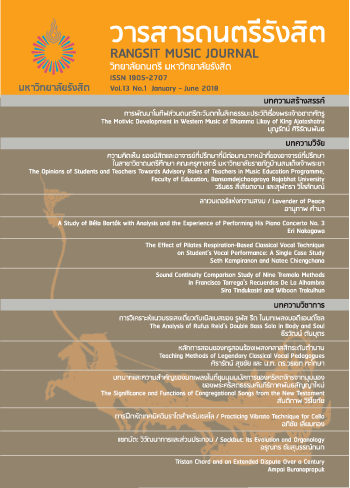A Study of Béla Bartók with Analysis and the Experience of Performing His Piano Concerto No. 3
Keywords:
Bartok, Piano Concerto, Night MusicAbstract
The Hungarian Composer Béla Bartók (1881–1945) displayed his prominent talent in music from a very young age. He entered the Budapest Academy of Music in 1899, studying piano with István Thomán, a student of Franz Liszt; and composition with János Koessler, a devotee of the music of Johannes Brahms. Bartók’s early compositions reflect the influences of Liszt, Brahms, and Richard Strauss. In 1915 he met Zoltán Kodály, with whom he became a lifelong friend and conducted joint research, collecting and transcribing thousands of folksongs from remote villages in Hungary, Slovakia, and Romania until 1918. He incorporated folk-oriented elements into his compositions. He was also influenced by the works of Claude Debussy and Igor Stravinsky. The Piano Concerto No. 3 was his last composition, written in 1945 while in America, where he spent his last five years battling illness and economic hardship. The author performed the concerto with the Thailand Philharmonic Orchestra in 2017 and describes the concerto in detail, discussing her experience of preparing and performing it.
References
2. Bartók, Béla. Concerto No. 3 for Piano and Orchestra, Edited by Alexander Mndoyants. Moscow: Muzyka, n.d. Accessed June 1, 2016. Petrucci Music Library, International Music Score Library Project.
3. ____________. Piano Concerto No. 3: Reduction for 2 Pianos. London: Boosey & Hawkes Music Publishers, 1994.
4. Bartók, Peter. My father. Translated by Yasuhiro Murakami. Tokyo: Stylenote, 2013.
5. Burge, David. Twentieth-Century Piano Music. Lanham, MD: Scarecrow Press, 2004.
6. Fassett, Agatha. The Naked Face of Genius. Translated by Mizuho Nomizu. Tokyo: Misuzu Shobo, 1973.
7. Gillies, Malcolm. “Bartók in America.” In The Cambridge Companion to Bartók, edited by Amanda Bayley, 190-201. Cambridge: Cambridge University Press, 2001.
8. Gordon, Stewart. A History of Keyboard Literature. New York: Schirmer Books, 1996.
9. Griffiths, Paul. Bartók. Translated by Akira Wada. Tokyo: Tairyusha, 1986.
10. Nissman, Barbara. Bartók and the Piano: A Performer’s View. Lanham, MD: Scarecrow Press, 2002.
11. Somfai, László. Bartók: Composition, Concepts, and Autograph Sources. Berkeley: CA University of California Press, 1996.
12. Stevens, Halsey. The Life and Music of Béla Bartók. Oxford: Clarendon Press, 1993.







